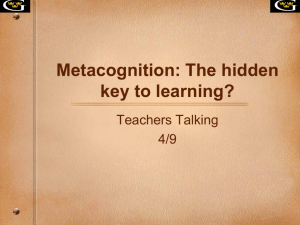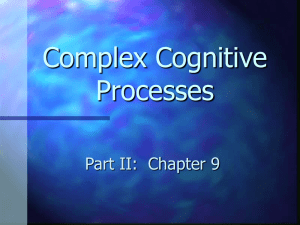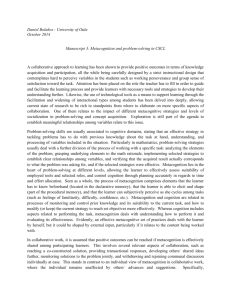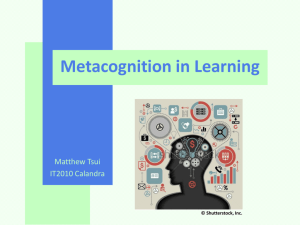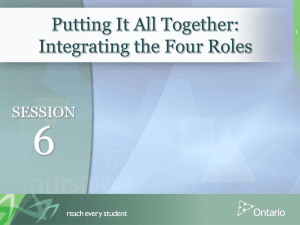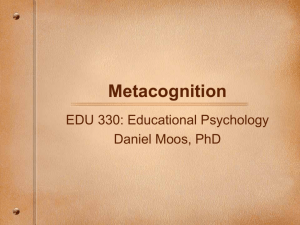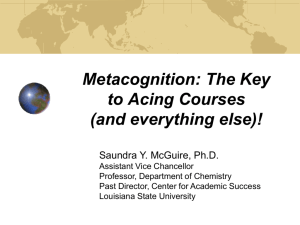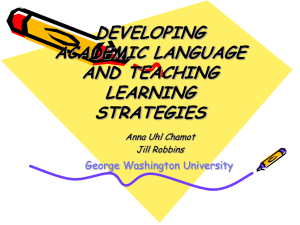Role of Metacognition in Natural and Artificial Systems Rohini.V and Natarajan A.M
advertisement
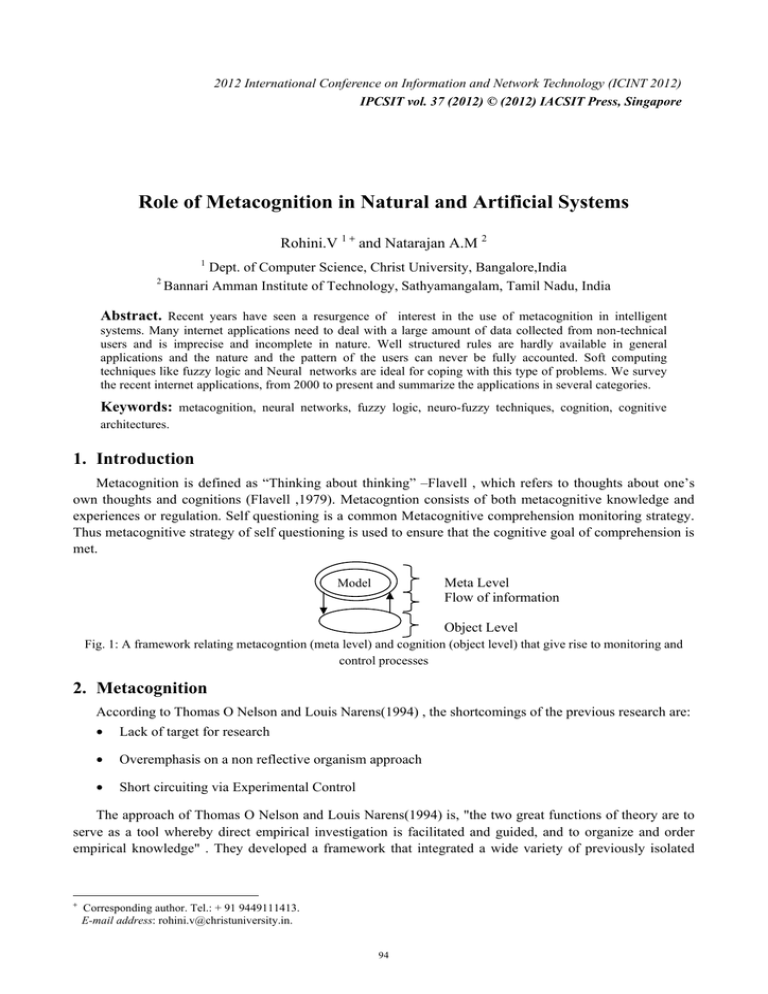
2012 International Conference on Information and Network Technology (ICINT 2012) IPCSIT vol. 37 (2012) © (2012) IACSIT Press, Singapore Role of Metacognition in Natural and Artificial Systems Rohini.V 1 + and Natarajan A.M 2 1 2 Dept. of Computer Science, Christ University, Bangalore,India Bannari Amman Institute of Technology, Sathyamangalam, Tamil Nadu, India Abstract. Recent years have seen a resurgence of interest in the use of metacognition in intelligent systems. Many internet applications need to deal with a large amount of data collected from non-technical users and is imprecise and incomplete in nature. Well structured rules are hardly available in general applications and the nature and the pattern of the users can never be fully accounted. Soft computing techniques like fuzzy logic and Neural networks are ideal for coping with this type of problems. We survey the recent internet applications, from 2000 to present and summarize the applications in several categories. Keywords: metacognition, neural networks, fuzzy logic, neuro-fuzzy techniques, cognition, cognitive architectures. 1. Introduction Metacognition is defined as “Thinking about thinking” –Flavell , which refers to thoughts about one’s own thoughts and cognitions (Flavell ,1979). Metacogntion consists of both metacognitive knowledge and experiences or regulation. Self questioning is a common Metacognitive comprehension monitoring strategy. Thus metacognitive strategy of self questioning is used to ensure that the cognitive goal of comprehension is met. Meta Level Flow of information Model Object Level Fig. 1: A framework relating metacogntion (meta level) and cognition (object level) that give rise to monitoring and control processes 2. Metacognition According to Thomas O Nelson and Louis Narens(1994) , the shortcomings of the previous research are: • Lack of target for research • Overemphasis on a non reflective organism approach • Short circuiting via Experimental Control The approach of Thomas O Nelson and Louis Narens(1994) is, "the two great functions of theory are to serve as a tool whereby direct empirical investigation is facilitated and guided, and to organize and order empirical knowledge" . They developed a framework that integrated a wide variety of previously isolated + Corresponding author. Tel.: + 91 9449111413. E-mail address: rohini.v@christuniversity.in. 94 findings and that highlighted empirically tractable questions about metamemory for future research to on explore. Their framework mainly has three stages as Acquisition, Retention and Retrieval. According to Mustafa et al. (2007), Metacognitive thinking occurs when you think about your cognitive level thinking. The term metacognition refers to thinking about: How you will perform a task or how you are performing a task, and the knowledge that you have to perform it, then monitoring and regulating those thinking processes and that knowledge while you perform the task. According to Gregory Schraw(1998), a framework is generated for understanding metacognition as follows : • • • Knowledge of cognition Declarative knowledge Issues of generality: How domain general metacogntive knowledge is related to domain specific knowledge & how metacognition is related to cognitive abilities. 3. Toward a Cognitive Neuroscience of Metacognition According to Arthur P Shimamura(2000), the relationship between metacognition ad executive control is explored. According to an analysis by Fernandez-Duque, Baird, and Posner, metacognitive regulation involves attention, conflict resolution, error correction, inhibitory control, and emotional regulation. These aspects of metacognition are presumed to be mediated by a neural circuit involving midfrontal brain regions. An evaluation of the proposal by Fernandez-Duque et al. is made, and it is suggested that there is considerable convergence of issues associated with metacognition, executive control, working memory, and frontal lobe function. By integrating these domains and issues, significant progress could be made toward a cognitive neuroscience of metacognition. Finally, there is incontrovertible evidence suggesting a trend toward a cognitive neuroscience perspective for many if not all aspects of human cognition. The advent of event-related fMRI (D’Esposito, Zarahn, & Aguirre, 1999) has brought behavioral paradigms used in neuroimaging studies closer to those commonly used in basic cognitive research. 4. Ontology Development According to Aaran Sloman Intelligent systems may be born or designed with the ontology’s they need to use in perceiving and categorizing things (a feature of precocial biological species), or, as in some antiracial species Sloman and Chappell (2005), may have to develop their own ontologies through exploration and experiment, using mechanisms that evolved to support self extension driven by interaction with an environment containing 3-D structures and processes as well as other intelligent individuals. Chappell and Sloman (2007) refer to largely genetically determined competences as “preconfigured” and those produced by layers of acquired competences as “meta-configured”. A Meta-Turing Test for Theories of Mentality At present the scope for theories of meta-cognition, including meta-management, seems to be very unconstrained. A possible constraint is suggested in Sloman (2007b), namely: an adequate theory of human meta-cognition should be capable of explaining how different thinkers with the same architecture can reach opposed views on many philosophical problems about mind, e.g. about the nature of human consciousness, human free will (Sloman 1992), human emotional states, and other controversial philosophical topics. According to Chris Tseng (2007), Fuzzy Logic is the ability to model imprecise and qualitative knowledge and handle uncertainty are distinguished characteristics of fuzzy sets. Fuzzy logic is capable of addressing approximate or vague notions that are inherent in many information retrieval (IR) tasks. For the top internet application, i.e., internet search engines, users typically are not domain expert and therefore cannot articulate the search with the intended keywords as inputs to search engines, which is a natural solution to this. 5. Neural Networks Neural networks were earlier thought to be unsuitable for deduction because of their inherent black-box nature. No information in symbolic form is needed to train the neural network for subsequent classification and/or deduction beyond its domain of training. There has also been active research aimed at extracting the 95 embedded knowledge in trained networks in the form of symbolic rules. This serves to identify the attributes that are needed in performing classification. Many internet applications that need to be classified do not have explicit symbolic rules. Unlike fuzzy sets, the main use of neural nets in internet applications are in the area of rule extraction and clustering. 6. Information Retrieval and eCommerce Applications Information retrieval over the internet has always been the key application of internet. It is a challenging problem as the data structure is typically not available to the information seeker. The need to recover information from system with no clear structure is an ideal task for neural network. Use of fuzzy semantic to extend the search scope for a better result has also been conducted. eCommerce has been the main interest of internet applications and various new techniques have been researched in recent years to solve emerging problems like automated help in finance process, personalized product recommendation and self-guided shopping process. Numerous neural network and fuzzy logic based designed have shown to be helpful in all these eCommerce processes. 7. Cognitive Architectures Cognitive architectures play a vital role in providing the blueprints for building the future intelligence systems supporting a broad range of capabilities similar to those of humans. According to Duch, Oentraryo,Pasquier, cognitive architectures are frequently created to model human performance in multi model multiple task situations rather than to create AGI(Artificial general Intelligence). SOAR(State,Operator And Result) is a rule based cognitive architecture designed to model general intelligence. EPIC(Executive process Interactive Control) is a cognitive architecture for building computational intelligence models that subsume many aspects of human performance. ICARUS defines an integrated cognitive architecture for physical agents, with knowledge specified in the form of reactive skills, each denoting goal relevant reactions to a class of problems. NARS(Non Axiomatic Reasoning System) is a reasoning system based on the language for knowledge representation, an experience grounded semantics of the language, a set of inference rules, a memory structure, and a control mechanism, carrying out various high level cognitive tasks as different aspects of the same underlying process. SNePS (Semantic Network Processing System)is a logic , frame and network based knowledge representation , reasoning and acting system that went through over three decades of development. IBCA (Integrated Biologically based Cognitive Architecture)is a large scale emergent architecture that epitomizes the automatic and distributed notions of information processing in the brain. Cortronics is a new emergent architecture that models the biological functions of the cerebral cortex and thalamus system in the human brain. NuPIC (Numenta Platform for Intelligent Computing) is an emergent architecture based on the Hierarchical Temporal Memory(HTM)technology, which is modeled on the putative algorithm used by neocrotex. NOMAD(Neutrally Organized Mobile Adaptive Device) automata are based on “ Neural Darwinism” theory. ACT-R (Adaptive Components of Thought – Rational) is a hybrid cognitive architecture and theoretical framework for emulating and understanding human cognition. CLARION(Connectionist Learning Adaptive Rule Induction ON-line) is a hybrid architecture that incorporates the distinction between explicit (symbolic) and sub-symbolic processes and captures the interactions between the two. LIDA (Learning Intelligent Distribution Agent) is a conceptual and computational framework for intelligent, autonomous, “conscious”, software agent that implements some ideas of the global workspace theory. DUAL architecture has been inspired by Minskey’s “Society of mind” theory of cognition. It is a multi agent general purpose architecture supporting dynamic emergent computation, with a unified description of mental representation, memory structures, and processing mechanisms carried out by small interacting micro agents. Polyscheme integrates multiple methods of representation, reasoning and inference schemes in problem solving. 4CAPS architecture has plausible neural implementation and is designed for complex tasks, such as language comprehension, problem solving or spatial reasoning. Shruti, biologically inspired model of human reflexive inference, represents in connectionist architecture relations, types, entities and casual rules using focal clusters. The Novamente AI Engine is based on system theoretic ideas regarding complex mental dynamics 96 and associated emergent patterns, inspired by the psynet model and more general “patternist philosophy of mind”. According to Abdel-Badeeh,Salem (2006)Machine learning (ML) aims at providing computational methods for accumulating, changing and updating knowledge in intelligent systems, and in particular learning mechanisms that will help us to induce knowledge from examples or data. ML provides methods , techniques, and tools that can help solving diagnostic and prognostic problems in a variety of medical domains. They have suggested the usage of rough sets and genetic algorithms. According to Yuhui liu & Hao Feng(2011), the relationship between metacognitive strategies and online learning behavior and test achievements is analyzed with suggestions for strategy training and ability development. According to Bertilo Frederico Becker(), Computational simulations for neural behavior networks of several levels showed the ability of generalization and abstraction. Distancing the output level from the input level has an effect of dissociation. This is to indicate that the development of abstraction, dissociation and generalization in human have a common bias in the multilevel structure of the neural connection in the brain. According to Zhang Yanyan & Wuhan University, Recent decades has witnessed an increasing recognition of the importance of metacognitive knowledge in cognitive activities related to language use and acquisition (e.g., Baker & Brown, 1984; Devine, 1993; Flavell, 1979; Kasper, 1997; Vandergrift, 002; Wenden, 1998;Xu & Tang, 2007). 8. Conclusion We see a growing interest in using fuzzy logic and neural network for finding the role of metacognition in the past 10 years. The inherent capability of neuro-fuzzy techniques in handling vague, large-scale, and unstructured data is an ideal match for metacognition related problems. Earlier research tends to focus on how to extract needed information from unstructured internet data. Lately, we have seen the use of neurofuzzy methodologies in building a structure web. Semantic web is one example of such. The notion of a structure web can be made more realistic when the concept of fuzzy logic is employed since web data tend to be fuzzy in nature. We expect to see an integration of soft computing techniques in Semantic web methodologies in the near future. Genetic algorithm for internet application should also become more popular as internet applications get larger in scale. 9. References [1] Agarwal, S.; Agarwal, P, “A Fuzzy Logic Approach to Search Results’ Personalization by Tracking User’s Web Navigation Pattern and Psychology”, Tools with Artificial Intelligence, 2005, 14-16 Nov. 2005 pages 318 – 325. [2] Berardi-Coletta, B., Buyer, L.S. Roger L., Dominowski, R.L., and Rellinger, E.R., Metacognition and Problem Solving: A Process-Oriented Approach, Journal of Experimental Psycology Learning , Memory, and Cognition,Vol.21(1), 205-223, 1995. [3] Chappell, J., and Sloman, A. 2007. Natural and artificial meta-configured altricial information- Processing systems. International Journal of Unconventional Computing 3(3):211–239. [4] Chen, L. J., Ho, R. G., & Yen, Y. C. (2006, Octber). Effects of metacognition evaluated strategy on computerbased test system. Paper presented at the E-Learn 2006 Conference, October 13-17, Honolulu, Hawaii, USA. [5] Cheng-Zhong Xu Tamer I. Ibrahim, “A Keyword-Based Semantic Prefetching Approach in Internet News Services” Transactions on Knowledge and Data Engineering, Volume 16 , Issue 5 (May 2004) Pages 601 – 611. [6] Chris Tseng, Toan Vu,” A perception-based web search with fuzzy semantic”, CS department, San Jose State University, One Washington Square, San Jose, CA 95192, USA. [7] Chris H Tseng, Internet Applications with Fuzzy Logic and Neural Networks : A Survey , Journal of Engineering, Computing and Architecture, 2007 [8] David Parry , A fuzzy ontology for medical document retrieval, The Australian workshop on Data Mining and Web Intelligence, Dunedin, 2004 [9] Etelapelto, A., Metacognition and the expertise of computer program comprehension, Scandinavian Journal of Educational Research,37, 1993. 97 [10] Eveland, W. P., Jr., & Dunwoody, S. Applying research on the uses and cognitive effects of hypermedia to the study of the World Wide Web. In W. Gudykunst (Ed.) Communication yearbook 25. [11] Fernandez-Duque, D., Baird, J. A., & Posner, M. I. (2000). Executive attention and metacognitive regulation. Consciousness and Cognition, 9, 288–307. [12] Flavell, J.H., Metacognitive aspects of problem solving. In Resnick,L. (Ed.), The nature of Intelligence, .Hi.ldsdale, N.J., Lawrence Erlbaum Associates, Inc., 1976. [13] Gama, C.: Integrating Metacognition Instruction in Interactive Learning Environments, Computer Science, University of Sussex, Brighton, UK, 2005. [14] Gourgey A.F., (2001), Developing students’ metacognitive knowledge and skills. In H.J. Hartman (Ed.), Metacognition in learning and instruction: theory, research and practice, Kluwer Academic Publishers, Dordrecht, The Netherlands, pp.17-32. [15] Hacker, D.J.: (Ed.) Metacognition: Definitions and Empirical Foundations, Lawrence Erlbaum Associates, Hillsdale, NJ, 1998. [16] Hartman, H.J., Metacognition in teaching and learning: An introduction. Instructional Science, 1998. [17] Jacobs, L. C., & Chase, C. I. (1992). Developing and Using Tests Effectively: A Guide for Faculty, San Francisco, CA: Jossey- Bass. [18] Kruschwitz, U. (2003). "An adaptable search system for collections of partially structured Documents." Intelligent Systems, IEEE 18(4): 44-52. [19] Kyung-Joong Kim, Sung-Bae Cho, "A personalized Web search engine using fuzzy concept network with link structure", IFSA World Congress and 20th NAFIPS International Conference, 2001, Volume 1, Issue , 25-28 July 2001 pages 81 - 86 vol. 1. [20] Lin, X.D.; Lehman, J.D.: Supporting learning of variable control in a computer-based biology environment: Effects of prompting college students to reflect on their own thinking, Journal of Research in Science Teaching, 36 (1999), pp. 837–858. [21] Li-Ju Chen, Rong-Guey Ho and Yung-Chin Yen, Marking Strategies in Metacognition-Evaluated Computer-Based Testing [22] Lucarella, D., & Zanzi, A. (1993). Browsing and searching in hypertext systems. Journal of Computing in Higher Education, 4(2), 79–105. [23] Melanie M. Cooper, Santiago Sandi-Urenab, Ron Stevens, Reliable multi method assessment of metacognition use in chemistry problem solving,2008 [24] Mustafa H, Kemp E A, Kemp R H, Computer Based Metacognitive Training: Improving the Diagnostic Expertise of Novice Graduates , ICL 2007, Conference, Villach, Austria,2007 [25] Nelson Thomas O, Narens Louis , Why Investigate Metacognition?,1994 [26] Shimamura P Arthur, Toward a Cognitive Neuroscience of Metacognition, Conciousness and Cognition 9, 313 – 323, 2000 . [27] Sloman, A., and Chappell, J. 2005. The Altricial-Precocial Spectrum for Robots. In Proceedings IJCAI’05,1187– 1192.Edinburgh:IJCAI. http://www.cs.bham.ac.uk/research/cogaff/05.html#200502 [28] Sloman, A. 1971. Interactions between philosophy and AI: The role of intuition and non-logical reasoning in intelligence. In Proc 2nd IJCAI, 209–226. London: William Kaufmann. http://www.cs.bham.ac.uk/research/cogaff/04.html#200407 [29] Sloman, A. 2008a. Architectural and representational requirements for seeing processes and affordances. Research paper, for Workshop Proceedings COSY-TR-0801, School of Computer Science, University of Birmingham, UK. http://www.cs.bham.ac.uk/research/projects/cosy/papers [30] Sloman Aaron , Varieties of Metacognition in Natural and Artificial systems, association for the advancement of Artificial Intelligence, 2008 [31] Takahashi , Murata , Role of Metacognition to promote strategy transfer in problem solving ,IEEE , 2001 [32] Vu, K.L., Hanley, G.L., Strybel, T.Z., and hoctor, R.W., metacognitive Processes In Human- Computer Interaction, 98 Self- Assessments of Knowledge as Predictor of Computer Expertise, International Journal of Human Computer Interaction, 12(1),43-71,2000. [33] Wen, Qiufang & Wang, Lifei. (2003a). Empirical Researches on English Learning Strategies. Xi’an: Shaanxi Normal University Press. [34] Xiao, Wuyun & Cao, Qunying. (2005). Teaching research on metacognitive strategies and learner autonomy. Journal of Educational Science of Hunan Normal University 5, 108-111. [35] Xu, J. F. & Tang F. (2007). A study of differences in the metacognitive knowledge of good and poor English writers. Journal of PLA University of Foreign Languages, 30(6), 44-48. 99
